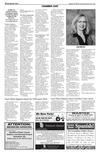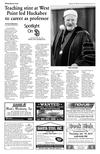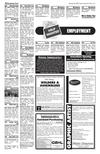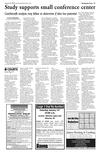bp_011012_010.pdf
10 Broadcaster Press
January 10, 2012 www.broadcasteronline.com
There goes
the neighborhood
Cypress Court, Redwood
Court fall to wrecking crew
By David Lias
david.lias@plaintalk.net
A couple of modest brick buildings
that for decades provided cheap and
cozy housing to married students at the
University of South Dakota have fallen
to a wrecking ball.
Or, to be more accurate, large
backhoes, bulldozers and trucks that
have been busily hauling away what’s
left of Cypress Court and Redwood
Court.
The two buildings on USD’s
campus, located on Pine Street, have
been easy to miss in recent years, even
though they are located only about a
block south of Cherry Street, which
carries the brunt of Vermillion’s traffic.
A tall stand of evergreen trees along the
housing units’ north edge obscured the
buildings.
According to a description of a
photo of one of the Cypress Court
apartments, on file in the Digital
Library of South Dakota web page,
Cypress Court was constructed in 1958.
“The University of South Dakota
received a substantial loan to build
Cypress Court and an addition to Julian
Hall,” according to the photo
description. “Cypress Court consisted
of 40 small apartments and was
inhabited by married students.
Redwood Court joined the
neighborhood two years later.”
Cypress and Redwood Courts were
also featured prominently on a page of
the 1967 “Coyote,” USD’s yearbook.
Among several photos of the buildings’
exteriors and a young university family
enjoying the simple comforts provided
by the small apartments are pictures of
the local families that managed the
buildings at the time – Marvin Van
Kekerix and his wife, Gloria, managed
Cypress Court. Dick Worman and his
wife, Mary, managed Redwood Court.
According to the yearbook, “The
married students of USD enjoy the
comfort and convenience of Cypress
and Redwood Courts. Each provides 40
modern efficiency apartments available
to the married student and his wife.”
Leading to the buildings’ demise is
the small size of each apartment, the
changes over the years in housing needs
and tastes of married USD students
with young families, and the recent
construction of Coyote Village on the
northern edge of campus near the
DakotaDome.
The fate of the two buildings was
sealed in the spring of May 2009 during
a South Dakota Board of Regents
meeting on the USD campus. At that
meeting, the Regents authorized
university officials to go ahead with its
plans to construct Coyote Village.
“It (Coyote Village) will allow us to
raze Cypress (Court) and Redwood
Court,” Richard Van Den Hul, who
served as USD’s vice president of
finance and administration at the time,
told the Regents. It will also give the
university the option to transform
some double-occupancy rooms in
existing dorms to single-occupancy.”
“The demolition of the buildings is
part of a housing revitalization plan,”
Phil Carter, USD’s manager of media
relations, said Tuesday. “A couple years
ago, when the administration went
before the Board of Regents to discuss
the possibly of Coyote Village … they
laid out a plan to renovate some of the
existing residence halls on campus as
well as clear Redwood Court and
Cypress Court. So, we’re in the second
phase of that project.”
Carter said Tuesday that he didn’t
know for certain what use the
university has in mind for the space
that will be created on campus once the
rubble of the two demolished buildings
is removed.
“I do think that it falls in line with
that housing plan,” he said. “It perhaps
may be looked at as a place to put
another residence hall. I think it’s also
being reviewed as possibly parking or
possibly space for something else, such
as another project on campus, another
building. I’m not 100 percent sure, but
MAIN PHOTO: Workers use large backhoes and bulldozers to reduce Cypress Court and Redwood
Court on the University of South Dakota campus to rubble last week. The two buildings were constructed over 50 years ago to serve as housing for married students.
(Photo by David Lias)
ABOVE PHOTO: Cypress Court and Redwood Court each featured 40 small, modest apartments, as
shown in this photo taken shortly after Cypress Court was constructed in 1958. The two buildings
served the housing needs of married students as recently as 2008.
(Archives and Special Collections, University Libraries, USD)
taking the buildings off line and
demolishing obviously opens up a good
chunk of real estate on campus.”
Carter said the two buildings have
been “off line,” in other words, not used
on a regular basis by the university, for
approximately the last two years.
“At one point, they were being used
for staging by the Vermillion Police
Department, event the state (Highway)
Patrol, and of course University Police
here to conduct scenarios for training,”
he said. “Even though they were off
line, they certainly weren’t empty and
they were being utilized as a benefit to
law enforcement.”
Before the demolition began,
workers combed through the buildings,
removing windows, metal and other
materials that could be recycled or sold.
The same process continued as the
walls were torn down, as it appears
workers used their heavy equipment to
sort pipe and metal into piles that
eventually were hauled away in large
trucks.
“It’s all about sustainability,” Carter
said. “If you can re-use the materials,
the better.”
Less than four years ago, Cypress
Court and Redwood Court were still
fulfilling their original role as housing
for married USD students. The Volante,
USD’s student newspaper, featured the
lifestyles of couples living in the
apartments in October 2008.
Jacquelin Boyle, a USD senior at
? COURTS, Page 11
su|do|ku
© 2008 KrazyDad.com
Fill the puzzle so that every row, every column, and every
section contain the numbers 1-9 without repeating a number
9
8
6
5 1
1 2
4
7
4
3
6
9
7
5 2
7
2
6
6 8
5
4
Check today’s issue for
the solution to the puzzle.
1
INT Book 28 #3













 Previous Page
Previous Page





